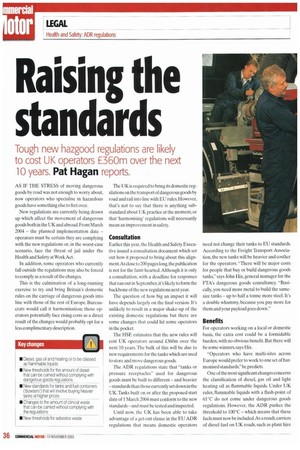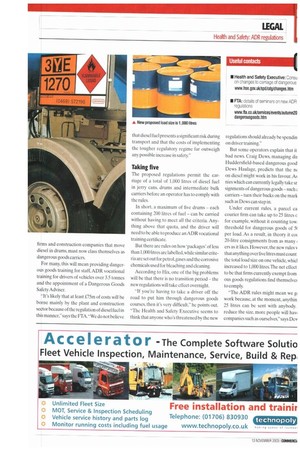Raising the standards
Page 36

Page 37

If you've noticed an error in this article please click here to report it so we can fix it.
Tough new nazgood regulations are likely to cost UK operators -E360rn over the next 10 years. Pat Hagan reports.
AS IF THE STRESS of moving dangerous goods by road was not enough to worry about, now operators who specialise in hazardous goods have something else to fret over.
New regulations are currently being drawn up which affect the movement of dangerous goods both in the UK and abroad. From March 2004 — the planned implementation date — operators must be certain they are complying with the new regulations or, in the worst-case scenario, face the threat of jail under the Health and Safety at Work Act.
In addition, some operators who currently fall outside the regulations may also be forced to comply as a result of the changes.
This is the culmination of a long-running exercise to try and bring Britain's domestic rules on the carriage of dangerous goods into line with those of the rest of Europe. Bureaucrats would call it harmonisation: those operators potentially face rising costs as a direct result of the changes would probably opt for a less complimentary description. The UK is required to bring its domestic regulations on the transport of dangerous goods by road and rail into line with EU rules However, that's not to say that there is anything substandard about UK practice at the moment, or that harmonising' regulations will necessarily mean an improvement in safety.
Consultation
Earlier this year, the Health and Safety Executive issued a consultation document which set out how it proposed to bring about this alignment.At close to 200 pages long,the publication is not for the faint-hearted. Although it is only a consultation, with a deadline for responses that ran out in September, it's likely to form the backbone of the new regulations next year.
The question of how big an impact it will have depends largely on the final version. It's unlikely to result in a major shake-up of the existing domestic regulations but there are some changes that could hit some operators in the pocket.
The HSE estimates that the new rules will cost UK operators around £360m over the next 10 years. The bulk of this will be due to new requirements for the tanks which are used to store and move dangerous goods.
The ADR regulations state that -tanks or pressure receptacles" used for dangerous goods must be built to different — and heavier —standards than those currently set down in the UK. Tanks built on or after the proposed start date of 1 March 2004 must conform to the new standards— and must be tested and inspected.
Until now the UK has been able to take advantage of a get-out clause in the EU ADR regulations that means domestic operators need not change their tanks to EU standards. According to the Freight Transport Association, the new tanks will be heavier and costlier for the operators. "There will be major costs for people that buy or build dangerous goods tanks," says John Hix, general manager for the ETA's dangerous goods consultancy. "Basically, you need more metal to build the samesize tanks — up to half a tonne more steel. It's a double whammy, because you pay more for them and your payload goes down."
Benefits
For operators working on a local or domestic basis, the extra cost could be a formidable burden, with no obvious benefit. But there will be some winners. ,says Mix.
"Operators who have multi-sites across Europe would prefer to work to one set of harmonised standards," he predicts.
One of the most significant changes concerns the classification of diesel, gas oil and fight heating oil as flammable liquids. Under UK rules, flammable liquids with a flash-point of 61°C do not come under dangerous goods regulations. However, the ADR pushes the threshold to 100°C — which means that these fuels must now be included.As a result, carriers of diesel fuel on UK roads, such as plant hire firms and construction companies that move diesel in drums, must now class themselves as dangerous goods carriers.
For many, this will mean providing dangerous goods training for staff. ADR vocational training for drivers of vehicles over 3.5 tonnes and the appointment of a Dangerous Goods Safety Adviser.
"It's likely that at least £75m of costs will be borne mainly by the plant and construction sector because of the regulation of diesel fuel in this manner," says the FTA."We do not believe that diesel fuel presents a significant risk during transport and that the costs of implementing the tougher regulatory regime far outweigh any possible increase in safety."
Taking five
The proposed regulations permit the carriage of a total of 1.000 litres of diesel fuel in jerry cans. drums and intermediate bulk carriers before an operator has to comply with the rules.
In short, a maximum of five drums each containing 200 litres of fuel can be carried without having to meet all the criteria. Anything above that quota. and the driver will need to be able to produce an ADR vocational training certificate.
But there are rules on how 'packages' of less than 1.000 litres are labelled.while similar criteria are set out for petrol,gases and the corrosive chemicals used for bleaching and cleaning.
According to 1-ix. one of the big problems will be that there is no transition period the new regulations will take effect overnight.
If you're having to take a driver off the road to put him through dangerous goods courses, then it's very difficult." he points out. "The Health and Safety Executive seems to think that anyone who's threatened by the new regulations should already be spendin on driver training."
But some operators explain that it bad news. Craig Dews, managing dit I luddersfield-based dangerous good Dews Haulage, predicts that the tit on diesel might work in his favour. As flies which can currently legally take sr signments of dangerous goods such a carriers turn their backs on the mark such as Dews can step in.
Under current rules, a parcel ca courier firm can take up to 25 litres c for example. without it counting tow threshold for dangerous goods of 5i per load. As a result. in theory it cot 20-litre consignments from as many ers as it likes. However, the new rules v that anything over five litres must count the total load size on one vehicle, whicl increased to 1,000 litres.The net effect to be that firms currently exempt from ous goods regulations find themselves to comply.
"The ADR rules might mean we gt work because, at the moment, anythin 25 litres can be sent with anybody. reduce the size, more people will havi companies such as ourselves," says Dev
































































































































































































